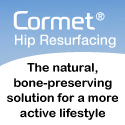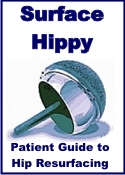|
|
The Management of Infected Total
Knee Arthroplasty
Link
http://www.orthosupersite.com/view.asp?rID=23597
By Fares S. Haddad, BSc,
MCh(Orth), FRCS(Orth); Ademola Adejuwon, MRCS(Eng)
ORTHOPEDICS 2007; 30:779
September 2007
Up to 2% of total knee
arthroplasties (TKAs) are complicated by infection. This leads to dissatisfied
patients with poor function, and has social and economic consequences. The
challenge is the eradication of infection, restoration of full function, and
prevention of recurrence.
A number of therapeutic
strategies exist for the management of infected TKA with the accepted gold
standard being two-stage revision arthroplasty combined with intravenous
antibiotic therapy. This usually is associated with long periods of
hospitalization, difficult mobility, pain, and financial ramifications. As a
result novel and less aggressive approaches are being attempted. Prosthesis
sparing early aggressive debridement in the acutely infected knee, antibiotics,
and single-stage knee revision should be considered.
Aggressive early debridement
The main goal is eradicating the infection while preserving the implant.
Twenty-nine cases of acutely infected knees (18 primaries and 11 revisions) that
occurred within 6 weeks of the index operation were reviewed. Microbiology
confirmed bacterial colonization in all cases with 20 early postoperative
infections and 9 cases of acute hematogenous spread. All patients underwent
aggressive open debridement, a thorough synovectomy, and a change of insert.
Systemic antibiotics were continued until inflammatory markers and the plasma
albumin concentration returned to within normal limits. A year following
cessation of treatment we had a 72% infection control rate.
The evidence suggests that a role exists for early aggressive open debridement
in acute knee infections with possible prosthesis salvage. This is only
appropriate in selective cases where infection occurs within the first 4 to 6
weeks after the onset of acute postoperative or acute hematogenous infection,
and in the absence of any prosthetic loosening.1 An aggressive and complete
debridement must be performed and systemic antibiotic administration is
imperative for success.
Combating TKA Infections With Antibiotics
The profile of bacterial infections colonizing joints has changed over the
past 10 years showing increasing drug resistance as demonstrated by the
emergence of methicillin-resistant Staphylococcus aureus (MRSA) and methicillin-resistant
Staphylococcus epidermidis (MRSE).2 The choice of antibiotic is based on the
culture sensitivities from specimens obtained from the infection site. It
usually is continued for six weeks following debridement before a decision to
discontinue is made based on clinical findings and inflammatory markers.
Combination antibiotic regimens such as rifampicin and ciprofloxacin have shown
good results at eradicating periprosthetic infections.3 Linezolid is good for
combating resistant organisms such as MRSA and MRSE.4 With good pharmacokinetics
its oral bioavailability is close to 100% allowing for an alternate mode of
administration.5 As a result of significant side effects of aplastic anemia and
peripheral neuropathy, the typical course of linezolid is limited to 28 days. In
our center we used linezolid for 26 periprosthetic infections (hips and knees).
Two cases were observed of pancytopenia and one neuropathy associated with the
drug; however fewer re-infections were noted in these patients than expected
from our previous experience.
Antibiotic suppression therapy alone should only be considered under special
circumstances as it may not successfully eradicate deep infection. In a
multi-center study, 40 (18%) of 225 infected TKAs had antibiotic suppression.6
Our criteria for the use of antibiotic suppression therapy alone are:
-
the patient is too
infirm to undergo a surgical procedure,
-
a pathogen of low
virulence that is susceptible to oral antibiotics, and
-
the prosthesis is
not loose.
Revision Arthroplasty
The choice of optimal management depends on duration and pathogenesis of
infection, stability of the implants, antimicrobial susceptibility of the
pathogens, and the condition of the soft tissues. Once chronic deep infection is
established, revision arthroplasty is required.
Thorough open debridement with
retention of the prostheses, particularly in the early postoperative stages or
after hematogenous acute infection remains an integral part of our
armamentarium. Adjuvant prolonged antibiotic therapy is necessary often up to 1
year. The use of rifampicin and ciprofloxacin has proved invaluable in this
regard.
Single stage exchange has been reserved for infirm patients who cannot tolerate
two-stage procedures. An aggressive bony and soft-tissue resection is combined
with appropriate antibiotic therapy that is continued until inflammatory and
nutritional markers normalize. Two-stage exchange remains the gold standard and
is used in >70% of our patients.
The treatment program is influenced by a number of factors, and decision making
is undertaken in a multidisciplinary setting with the support of infectious
diseases physicians and microbiologists.
The role for single-stage revision in knees is unclear.7 Having seen excellent
results with one-stage hip revisions for infections we have instituted a
protocol for revising the infected knee in the nonimmunocompromised patient. The
new protocol involves re-prepping and re-draping the patient between prosthesis
removal and reimplantation. Antibiotics are continued until inflammatory markers
return to within normal limits. Data currently is being collected to clarify a
role for single-stage TKA revision.
The two-stage revision with depot antibiotic loaded cement in the interval
period remains the accepted treatment with success rates of >90%.8,9 Antibiotic
loaded cement allows for higher effective concentrations than can be achieved
parenterally.5 Vacuum mixing of the cement is avoided to allow for a porous mix
to elute antibiotic. Antibiotic choice is based on sensitivities from
aspirations; however, some do not work well in cement, such as chloramphenicol
and rifampicin. In the absence of an organism, vancomycin (3 g/40 g of cement)
and gentamicin (2 g/40 g of cement) are used in high dosages. There is no
concern over the systemic safety of the doses involved6; however, when
performing second-stage reconstruction <5% per mass of cement should be used.
We administer intravenous teicoplanin intraoperatively and continue
administration until culture sensitivities are obtained. Antibiotics are stopped
after 6 weeks and re-implantation is performed between 8 to 12 weeks.
Between stages a mobile antibiotic spacer is used to maintain joint alignment
and prevent soft-tissue contractures. With a mobile articulating spacer during
second-stage surgery, less extensile exposures are required and a greater range
of movement compared to patients in whom a static spacer was used.
The timing of the second stage is based on clinical response. Antibiotics are
continued after the reimplantation until culture results are obtained. If there
is no growth on enrichment culture, antibiotics are stopped after five days,
otherwise appropriate antibiotic therapy is continued until the inflammatory
markers normalize.
Conclusion
Infection of a TKA is a catastrophic
complication for which we have yet to achieve optimal outcomes. The undeniable
gold standard management of two-stage revision is associated with multiple
morbidities and large expenditure.
Prosthesis sparing, aggressive early open debridement works for acute infections
within 4 to 6 weeks of the index operation or of hematogenous seeding.
The role of single-stage revision is unclear, but with the success of one-stage
hip revisions we have started to consider the single-stage knee revision in a
highly selected cohort. For the two-stage revision arthroplasty antibiotic
delivery can be improved by using antibiotic loaded cement and a mobile
articulating antibiotic loaded spacer.
Management of infected arthroplasties requires an appropriate multi-disciplinary
approach with close involvement of the infectious disease team to identify the
pathogens involved and treat the patient appropriately.
References
-
Tsukayama DT,
Estrada R, Ruperto RB. Infection after total hip arthroplasty. A study of
the treatment of one hundred and six infections. J Bone Joint Surg Am.
1996; 78:512-523.
-
Ip D, Yam SK, Chen
CK. Implications of the changing pattern of bacterial infections following
total joint replacements. J Orthop Surg (Hong Kong). 2005;
13:125-130.
-
Zimmerli W, Widmer
AF, Blatter M, Frei R, Ochsner PE. Role of rifampicin for treatment of
orthopedic implant-related staphylococcal infections: a randomized
controlled trial. Foreign-Body Infection (FBI) Study Group. JAMA.
1998; 279:1537-1541
-
Manfredi R,
Sabbatani S, Chiodo F. Severe staphylococcal knee arthritis responding
favourably to linezolid, after glycopeptide-rifampicin failure: a case
report and literature review. Scand J Infect Dis. 2005; 37:
513-517.
-
Rana B, Butcher I,
Grigoris P, Murnaghan C, Seaton RA, Tobin CM. Linezolid penetration into
osteo-articular tissues. J Antimicrob Chemother. 2002;
50:747-750.
-
Bengtson S, Knutson
K. The infected knee arthroplasty. A 6-year follow-up of 357 cases.
Acta Orthop Scand. 1991; 62: 301-311.
-
Buechel FF, Femino
FP, D�Alessio J. Primary exchange revision arthroplasty for infected total
knee replacement: a long-term study. Am J Orthop. 2004;
33:190-198.
-
Haddad FS, Masri
BA, Campbell D, McGraw RW, Beauchamp CP, Duncan CP. The PROSTALAC functional
spacer in two-stage revision for infected knee replacements. Prosthesis of
antibiotic-loaded acrylic cement. J Bone Joint Surg Br. 2000;
82:807-812.
-
Haleem AA, Berry
DJ, Hanssen AD. Mid-term to long-term followup of two-stage reimplantation
for infected total knee arthroplasty. Clin Orthop Relat Res.
2004; 428:35-39.
Authors
Drs Haddad and Adejuwon are from University College London & Princess
Grace Hospitals, London, United Kingdom.
Correspondence should be addressed to: Fares S. Haddad, BSc, MCh(Orth),
FRCS(Orth), University College London & Princess Grace Hospitals, c/o
42-52 Nottingham Place, London W1U 5NY, United Kingdom.
|
|





